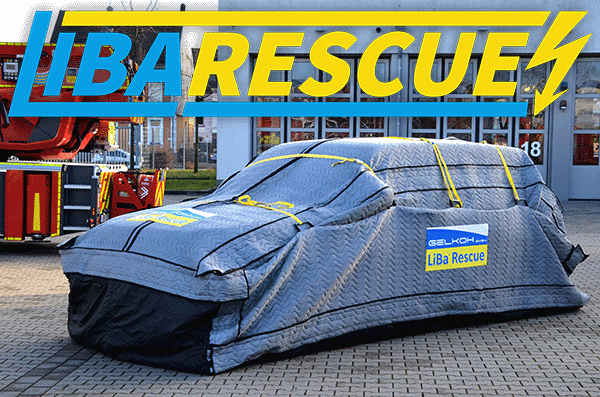Nefab Packaging UK and Gelkoh GmbH launch a new solution for controlling and avoiding fires in electric vehicles.
Northampton-based Nefab Packaging UK has added German battery-handling experts GelKoh's LiBa Rescue, a fire protection system for electric vehicles and lithium-ion (Li-Ion) batteries, to its product portfolio. The system is used to control and avoid fires in damaged electric vehicles, fires which can often continue for days after an accident or a fault with a battery itself.

The Challenge
"An electric vehicle's lithium-ion battery can pose a considerable threat especially if the battery is damaged as the result of an accident. The threat can continue over the course of several days or even weeks.", explains Christopher Fuchs, Managing Director of Nefab Packaging UK.
“Until now, because of the batteries‘ architecture - where the cells are surrounded by a strong outer casing - emergency services arriving on the scene of a crash or accident have had no alternative to prevent this thermal runaway other than to submerge the vehicle in a container filled with water. This is often done even as a “preventive measure”, causing huge damages to the vehicle itself. Not only has this caused immense damage to vehicles along with their contents, but has created two additional problems: Firstly, once the car has been recovered from the container, tens of thousands of liters of water from the container have had to be treated as contaminated waste, requiring specialist - and costly – treatment. Secondly, a battery that was not unstable before being submerged into water, after it has been recovered it will most certainly be severely damaged."
LiBa Rescue – The Solution
The German company GelKoh GmbH, a specialist manufacturer of UN-approved dangerous goods packaging solutions and safe workplace systems for lithium-ion batteries, has extended its strategic partnership with Nefab Packaging UK to now include the LiBa Rescue safety system. "The LiBa Rescue offers a much more environmentally friendly and safe way to treat damaged electric vehicles and their batteries," says Fuchs. "Using the LiBa Rescue, the damaged vehicle is packed into a thermally-stable, high-performance safety system, which offers a continuous use from transportation away from the crash site to a quarantine location and onwards to its final destinations such as garages for repair or dismantling of the vehicle. This gives all involved experts the time they require to analyze the status of the battery properly."
Download our Lithium-ion Battery brochure
Find out what makes Nefab a world leader in Lithium-ion Battery Transport Packaging
DownloadHow it works
Fuchs goes on: "Two operators can secure one vehicle in as little as three minutes until the car is completely safe and the risk of fire is averted. The car first needs to be rolled or lifted onto the bottom part of the LiBa Rescue. Additional lengths are then attached and secured in a patented design, creating a high-tech, non-conductive safety solution. The woven material is 'self-extinguishing', meaning that if a fire should break out inside the battery, the heat emitted from the fire will release gases from the material that extinguishes the fire. This provides a safe and stable environment for the whole vehicle even during transport. The LiBa Rescue provides a passive gas-management system whereby highly toxic hydrofluoric acid (a critical element of the harmful gases emitted by a lithium-ion battery on the thermal runaway) is neutralized as it passes through the system. Finally, the bottom layer of the LiBa Rescue is manufactured with a ceramic lining which will prevent fuel from a hybrid vehicle entering the soil or surface water and damaging aquatic biospheres."
Even the risk of an explosion has been considered during the design process of the LiBa Rescue, according to Fuchs. "The material has a very high permeability, allowing large amounts of gases to pass through the material," he explains. "This means that in the event of an explosion, gases will pass through the system without damaging or ripping it open. The membrane is strong enough to withstand exploding batteries and to prevent any projectiles from escaping."
Because the LiBa Rescue consists of several separate elements, damaged parts can either be repaired or exchanged at a fraction of the cost of an entirely new system. This will appeal to insurers who are currently facing high costs associated with electric vehicles involved in serious accidents. Firefighters will also value the fact that the system does not require any water - water isn't always readily available at crash sites, something that currently causes logistical problems at the site of an accident.
LiBa Rescue Details
GelKoh’s engineers have spent three years developing the LiBa Rescue and the product is now being launched on the market in 2021. LiBa Rescue is available in one standard size: 'SUV', adding additional segments to it, the system can be extended to be used for vans.
For more information please contact:
Christopher Fuchs
Managing Director
E-mail christopher.fuchs@nefab.com
Phone +44(0)1604 328 300

